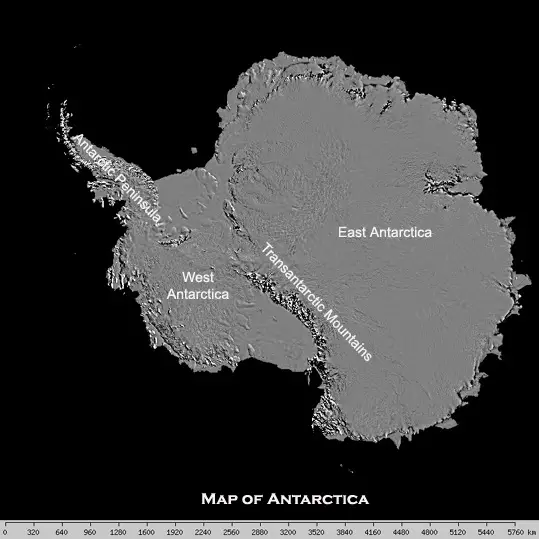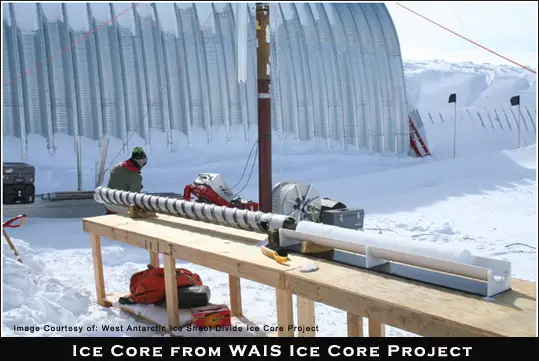The West Antarctic Ice Sheet(WAIS) is a unique marine ice sheet, anchored to bedrock, and in places it dips thousands of metres below sea level with margins that are floating. Other marine ice sheets existed in the Northern Hemisphere during the last glacial maximum but all disintegrated and melted away during the current warm period. The West Antarctic Ice Sheet is the only marine ice sheet remaining from the last glacial period. Marine ice sheets are important because their existence and future behaviour depend not only on atmospheric conditions and ice movement, but also on sea level changes.
As the sea level rises, more of the ice at the edge of the sheet floats, and the forces that hold the ice sheet together are reduced, causing ice to flow more rapidly to the oceans. This positive feed-back loop (sea-level rise, leading to reduced forces holding the ice together, leading to increased ice flow into the ocean, leading to sea level rise) could lead to rapid disintegration or collapse of a marine ice sheet. The present ice sheet would not need to melt and thin by much in order for the ice to begin to float. When the glaciers begin to float, warm ocean water is able to reach the undersides of the floating glacier tongues and melt rates increase significantly. This means that the West Antarctic ice sheet may be uniquely capable of rapid deglaciation (melting), and many scientists are quite concerned about this possibility. If the WAIS was to melt and disappear it would raise sea level by an average of 6 metres (19.6 feet).

After a decade of satellite measurements the ice sheet surface have shown that the portion of the ice sheet that drains into the Amundsen Sea is thinning at rates of several centimetres to several metres per year. Several neighbouring glacier basins appear to be behaving in a similar fashion, and thinning is most concentrated on the fast-moving parts of those glaciers, suggesting that this is the result of a dynamic change in the ice sheet itself rather than a change in snowfall.
The West Antarctic Ice Sheet is drained by surprisingly large, fast, river-like currents of ice flowing through the ice sheet. These ice streams, as they are called, are up to 100 kilometres wide and several hundred kilometres in length, moving at rates as fast as several hundred meters per year. Studies have shown that the ice streams are underlain by a water-saturated, unconsolidated sediment layer a few meters thick. This sediment acts to lubricate the ice streams so that they flow rapidly over their beds. The size and speed of the streams lead to the possibility of rapid collapse of the ice sheet. NASA scientists and leading climate advisers to the US government, are worried and have said, “Once a sheet starts to disintegrate, it can reach a tipping point beyond which break-up is explosively rapid.”
Research is continuing and the West Antarctic Ice Sheet Program is an interdisciplinary program developed to study this ice sheet, understand the processes important to its behaviour, and develop models to predict its future behaviour. Recent studies suggest a possible connection between the subglacial geology and the presence of the ice streams. In fact, measurements of ice thickness, magnetics, and gravity, made using a specially equipped aircraft, have shown that there is evidence for high heat flow and active volcanism near the ice streams. These elements could explain the high degree of subglacial melting and lubrication of the sediment under the ice streams. This work demonstrates the importance of subglacial geology for a complete understanding of the stability of the west Antarctic ice sheet, its ice streams, and its potential for raising global sea level.
WAIS Divide is a United States deep ice coring project in West Antarctica funded by the National Science Foundation (NSF) and is the second component to the larger WAISCORES initiative. The purpose of the WAIS Divide project is to collect a deep ice core from the flow divide in central West Antarctica in order to develop a unique series of interrelated climate, ice dynamics, and biologic records focused on understanding interactions among global earth systems.
The main science themes of the WAIS Divide project are:
– climate forcing by greenhouse gases;
– the role of Antarctica in abrupt climate change; – the relationship among northern, tropical, and southern climates;
– the stability of the West Antarctic ice sheet; and the biological signals contained in deep ice cores.
Visit the West Antarctic Ice Sheet Divide (WAIS Divide) Ice Core Project website for more information.

See Also
